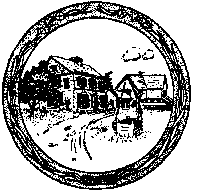



|
 NCE upon a time there was a farm-house, and it was painted
white and had green blinds; and
it stood not far from the road. In the fence was a wide
gate to let the wagons through to
the barn. And the wagons, going through, had made a
track that led up past the kitchen
door and past the shed and past the barn and past the
orchard to the
NCE upon a time there was a farm-house, and it was painted
white and had green blinds; and
it stood not far from the road. In the fence was a wide
gate to let the wagons through to
the barn. And the wagons, going through, had made a
track that led up past the kitchen
door and past the shed and past the barn and past the
orchard to the
In the morning, when Uncle John had
milked all the cows, he took all the milk, in the big
pails, to the
The spring-house was a little low house that was in the orchard, and a stream of water ran right through the middle of it. It was the same stream of water that ran on through the big field where the cows went to eat the grass, and then it ran on, under the road and through another field and into the river. They didn't have ice then, in the summer time, but the water of the little stream was cool, and they used that to keep the milk and the butter from getting too hot. They had made a trench for the water to run through, and in the bottom of the trench they had put great flat stones, so that the water ran over the stones. And on top of the stones the water wasn't deep at all.
So Uncle John took the milk to the spring-house and poured it into big flat pans, and set the pans in the water on the flat stones, so that the water would keep the milk cool while the cream came to the top. The cream is the yellow, fat part of milk, and when the milk stands still, the cream comes to the top.
Every time Uncle John had finished
milking the cows, he took the milk to the
![[Illustration]](http://www.gatewaytotheclassics.com/gold/books/hopkins/farm/hopkins_farm_zpage206.gif)
And when the milk had stood so
for as long as all day or all night,
When the cream in the jar was just right, Aunt Deborah
and Aunt Phyllis took it to the
buttery and put it in the churn, a kind of box that had
a long handle. And on the end of
the handle was a big piece of wood with holes all
through it. Then
![[Illustration]](http://www.gatewaytotheclassics.com/gold/books/hopkins/farm/hopkins_farm_zpage207.gif)
When it was done enough, Aunt Deborah poured off the watery stuff that they called buttermilk, and she washed the butter with water, and she put in a lot of salt. The buttermilk she saved, because sometimes people like to drink it. Then she took the butter that was all in little lumps, and she worked it together, so that the water came out of it, and it was all in big lumps. And she worked that all together until it was worked enough, and was in one big lump.
Then she got a little mould, a kind of cup with a
cover. And in the inside of the cover was a
picture, cut into the wood, of an ear of corn and some
marks all about. Then
When all the butter was made into pats, Aunt Deborah
put the pats into a great round
wooden box and carried the box out to the
And that's all.